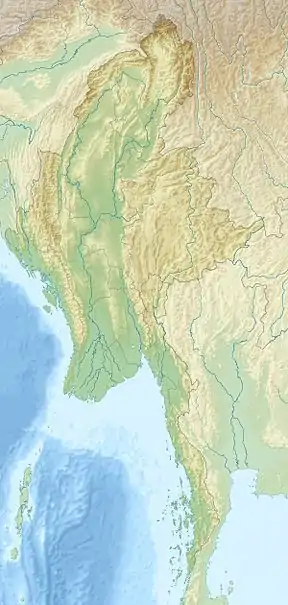Kachin Hills
The Kachin Hills are a heavily forested group of highlands in the extreme northeastern area of the Kachin State of Burma. It consists of a series of ranges running mostly in a N/S direction, including the Kumon Bum subrange of which the highest peak is Bumhpa Bum with an elevation of 3,411 metres (11,191 ft)[1] one of the ultra prominent peaks of Southeast Asia.
| Kachin Hills | |
|---|---|
 Kachin Hills | |
| Highest point | |
| Peak | Bumhpa Bum |
| Elevation | 3,411 m (11,191 ft) |
| Coordinates | 26°41′N 97°14′E |
| Geography | |
| Country | Burma |
| Region | Southeast Asia |
| Borders on | Burma, Arunachal Pradesh (India), Tibet and Yunnan (China) |
| Geology | |
| Type of rock | Granite, limestone |
Geography
The country within the Kachin hill tracts is roughly estimated at 19,177 square miles (49,670 km2), and consists of a series of ranges, for the most part running north and south, and intersected by valleys, all leading towards the Ayeyarwady River, which drains the whole country.
Kachin people
The Kachin Hills are inhabited by the Kachin or Chingpaw, who are known on the Assam frontier as Singphos and on the Chinese frontier as Jingpos. Owing to the great number of tribes, sub-tribes and clans of the Kachins, the part of the Kachin hills which has been taken under administration in the Myitkyina and Bhamo districts was divided into 40 hill tracts (since reduced to five). Beyond these tracts, there are many Kachins in Katha, Mong Mit and the northern Shan States.
There were 64,405 Kachins enumerated at the census of 1901.
In the middle of the 19th century, the southern limit of the Kachins was 200 mi. farther north than it is now. Since then the ethnic group has been drifting steadily southward and eastward, a vast aggregate of small independent clans united by no common government, but all obeying a common impulse to move outwards from their original seats along the line of least resistance. Now the Kachins are on both sides of the border of upper Burma, and are a force to be reckoned with by frontier administrators.
British administration
According to the Kachin Hill Tribes Regulation of 1895, administrative responsibility was accepted by the British government on the left bank of the Irrawaddy for the country south of the Nmaikha, and on the right bank for the country south of a line drawn from the confluence of the Malikha and Nmaikha through the northern limit of the Laban district and including the jade mines. The tribes north of this line were told that if they abstained from raiding to the south of it they would not be interfered with. South of that line peace was to be enforced and a small tribute exacted, with a minimum of interference in-their private affairs.
On the British side of the border, the chief objects of Britain's colonial policy were the disarmament of the tribes and construction of frontier and internal roads. A light tribute was exacted. The Kachins have been the object of many police operations and two regular expeditions:
(I) Expedition of 1892-93
Bhamo was occupied by the British on December 28, 1885, and almost immediately, trouble began. Constant punitive measures were carried on by the military police; but in December 1892, a police column proceeding to establish a post at Sima was heavily attacked, and simultaneously the town of Myitkyina was raided by Kachins. A force of 1,200 troops was sent to put down the rising. The enemy received their final blow at Palap, but not before three officers were killed, three wounded and 102 sepoys and followers killed and wounded.
(2) Expedition of 1895-96
The continued misconduct of the Sana Kachins from beyond the administrative border rendered punitive measures necessary in the eyes of British colonialists. No retaliation had taken place since the attack on Myitkyina in December 1892. Now two columns were sent up, one of 250 rifles from Myitkyina, the other of 200 rifles from Mogaung, marching in December 1895. The resistance was insignificant, and the operations were completely successful. A strong force of military police was stationed at Myitkyina, with several outposts in the Kachin hills.
In 1910, the British occupied Hpimaw (片马; Piànmǎ)[2] in the Pianma Incident, as well as a part of what is now Northern Kachin state in 1926/7 and part of the Wa states in 1940.[3][4]
Burma relinquished[5] the eastern villages of Hpimaw (Pianma) and adjacent Gawlam (Gulang) (古浪; Gǔlàng)[6] and Kangfang[5] (岗房; Gǎngfáng)[7] to the Chinese in 1960, ending the political boundary dispute. Although the area had been granted much autonomy under the 1947 constitution, the Burma government has since integrated it into the rest of the country.
References
- "Bumhpa Bum - Peakbagger.com". www.peakbagger.com.
- "Lúshuǐ Xiàn Piànmǎ Zhèn Piànmǎ Cūnwěihuì Xiàpiànmǎ Cūn" 泸水县片马镇片马村委会下片马村 [Xiapianma Village, Pianma Village Committee, Pianma Town, Lushui County]. ynszxc.gov.cn (in Chinese). Archived from the original on 2015-04-02.
- Gillogly, Kathleen (2006). "Transformations of Lisu Social Structure Under Opium Control and Watershed Conservation inNorthern Thailand" (PDF). evols.library.manoa.hawaii.edu. Retrieved 2020-09-13.
- "Yunnan | province, China". Encyclopedia Britannica.
- "International Boundary Study No. 42 – Burma-China Boundary" (PDF). US DOS. 30 November 1964. Archived from the original (PDF) on 31 January 2020. Retrieved 17 September 2020.
- "Lúshuǐ Xiàn Piànmǎ Zhèn Gǔlàng Cūnwěihuì" 泸水县片马镇古浪村委会 [Gulang Village Committee, Pianma Town, Lushui County]. ynszxc.gov.cn (in Chinese). Archived from the original on 2015-04-03.
- "Lúshuǐ Xiàn Piànmǎ Zhèn Gǎngfáng Cūnwěihuì" 泸水县片马镇岗房村委会 [Gangfang Village Committee, Pianma Town, Lushui County]. ynszxc.gov.cn (in Chinese). Archived from the original on 2015-04-02.
Sources
- This article incorporates text from a publication now in the public domain: Chisholm, Hugh, ed. (1911). "Kachin Hills". Encyclopædia Britannica (11th ed.). Cambridge University Press.